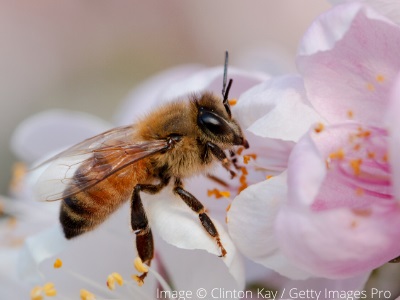May 2020
Authors: Jake Slinger & Michael Fox

Honey bee. Image © Clinton Kay from Getty Images Pro
Do you love that flash of colour of butterflies, the dawn chorus of birds or the mysterious buzz of bees in your garden?
I love all these experiences and I also love living in the city with all the conveniences and activities. Our non-profit Pollinator Link® project helps city dwellers have the best of both worlds with simple DIY projects delivering water, food and shelter for wildlife.
Creating a citywide mosaic habitat
Just 10 per cent, one in ten, of Brisbane gardens providing water, food and shelter will create a citywide mosaic habitat bringing birds, butterflies, bees and other wildlife back into our lives.
Brisbane has 320,000 detached houses. So, 10 per cent is 32,000 gardens providing water, food and shelter, and creating 862ha of habitat and movement solutions for wildlife.
Food: Plant local to feed locals
Use the Griffith University GroNative app (free to download from the app store or Google Play) to find local South East Queensland plants that caterpillars of local butterflies can eat.
Tallamy (2009), in Bringing Nature Home, reports that powerful defensive chemicals mean 90 per cent of insect herbivores can digest only a very limited range of plant species with which they evolved. The current practice is to plant city gardens with whatever is for sale in local retail nurseries where even “native” plants are often from another part of Australia.
A mixture of local natives and more common garden plants will create a food market for our local insects.
Butterflies and bees love common garden plants like:
- Basil
- Rosemary
- Lavender
Exotic citrus trees are good for Orchard Swallowtail butterfly caterpillars.
With the GroNative app, simply enter your postcode to access lists of local native plants for your suburb with photos, flowering times, plant size and a neat shopping list function for when you visit your local nursery.
Share your DIY projects
Please share your water, food, shelter, DIY projects, or even your ideas for projects that will help bring wildlife back into our city lives. Building the Resources section of our website will get more people to take action in their gardens.
DIY projects and posters are provided copyright-free to encourage sharing. Consider using Pollinator Link® materials for community engagement workshops for groups like kindies, schools, community gardens, scout groups, etc. Our team does regular workshops and displays to spread information about using water, food and shelter to bring the fun of wildlife back to urban gardens.
Backyard citizen scientist: iNaturalist
Using the iNaturalist app we can all collect research evidence to map the effectiveness of the Pollinator Link® project.
Anyone with a smartphone can be a backyard citizen scientist, including our kids. Imagine the feeling of achievement and engagement our young citizen scientists will experience when they report a new bird or find a new butterfly in their garden!
Research evidence will also inform the new Pollinator Link® Guardian scheme. ‘Guardians’ (You!) will be able to provide habitat for native solitary bees and contribute to research in understanding the nesting habits and life cycles of some of Australia’s solitary bees.
iNaturalist is the new, easy-to-use, front end for Atlas of Living Australia so all data collected will help environmental researchers right across Australia.
Giving urban wildlife a voice in the marketplace
The vision for the Pollinator Link® brand is to create a “pull strategy” where customers start asking for “local natives” at retail nurseries and developers want to use the brand to promote their new developments. We already have people coming to displays asking about Pollinator Link® because they have seen the sign on a neighbour’s fence.
So, even if you already have water, food and shelter in your garden, we need you to register your garden today to create a large network of Pollinator Link® gardens. Our goal of 30,000 registered sites across Brisbane (equates to around 40,000 voters) which will give our urban wildlife a voice with the government and other decision-makers.
Get involved
Register your garden, download and share GroNative and iNaturalist or use the online Resources to host a workshop or display.
- Find out more about Pollinator Link® on our website (https://pollinatorlink.org)
- Follow the project on Facebook, Twitter and Instagram: #waterfoodshelter @pollinatorlink
Sources:
Tallamy, D.W., 2009. Bringing Nature Home: How You Can Sustain Wildlife with Native Plants. Timber Press.
